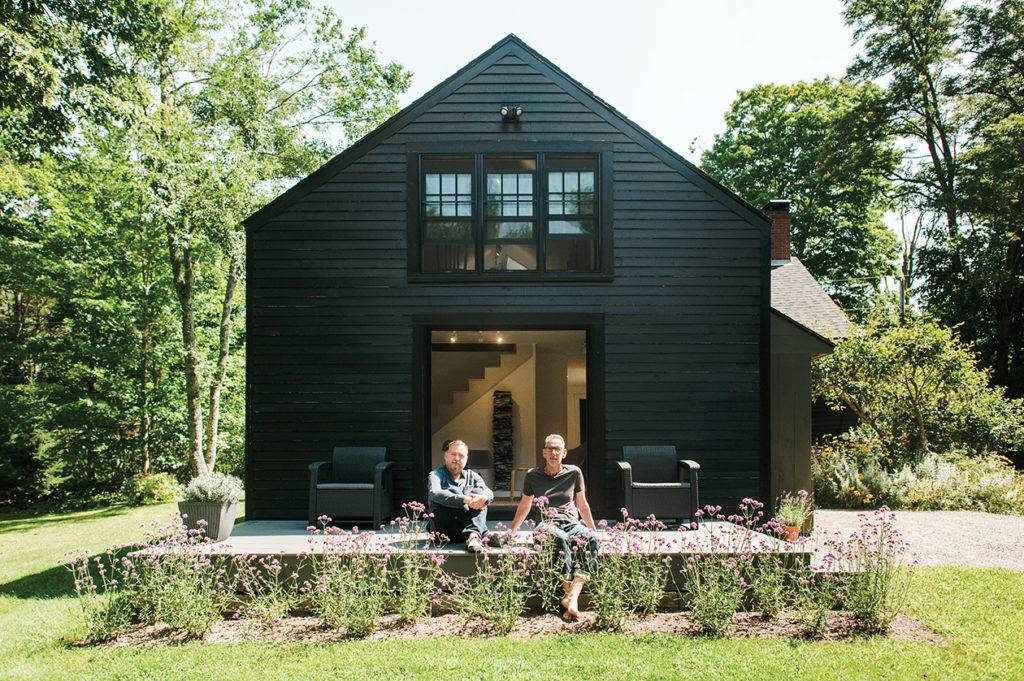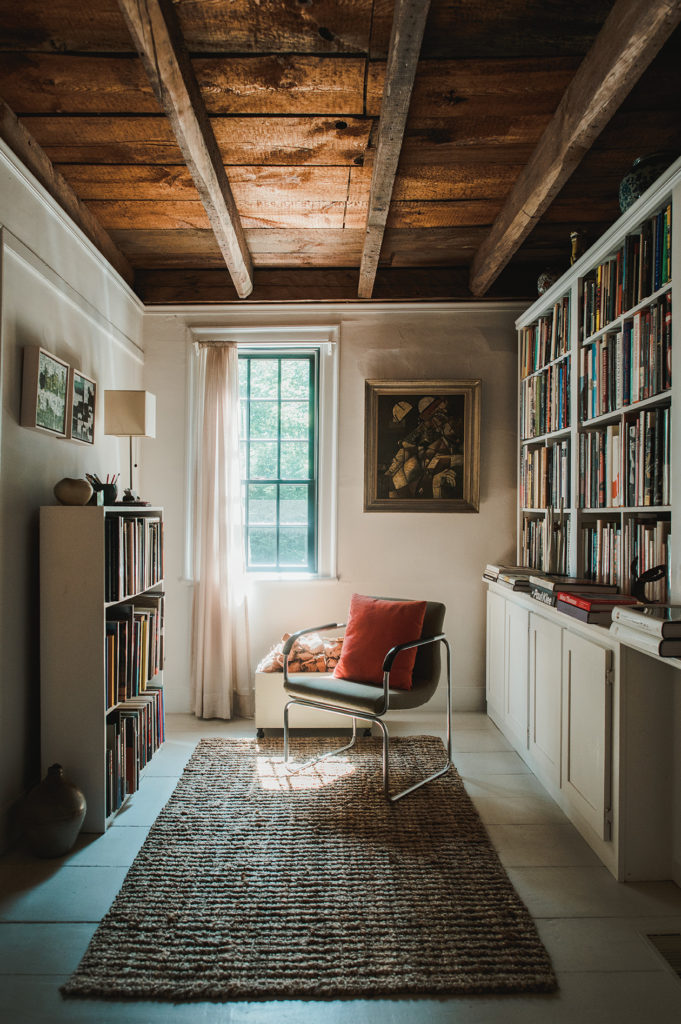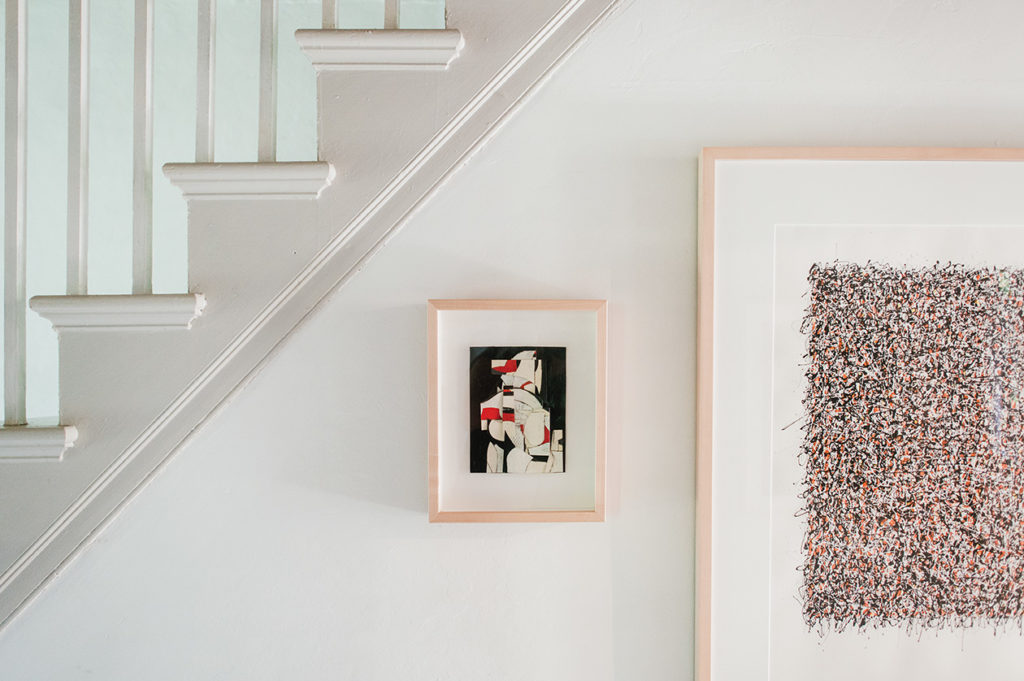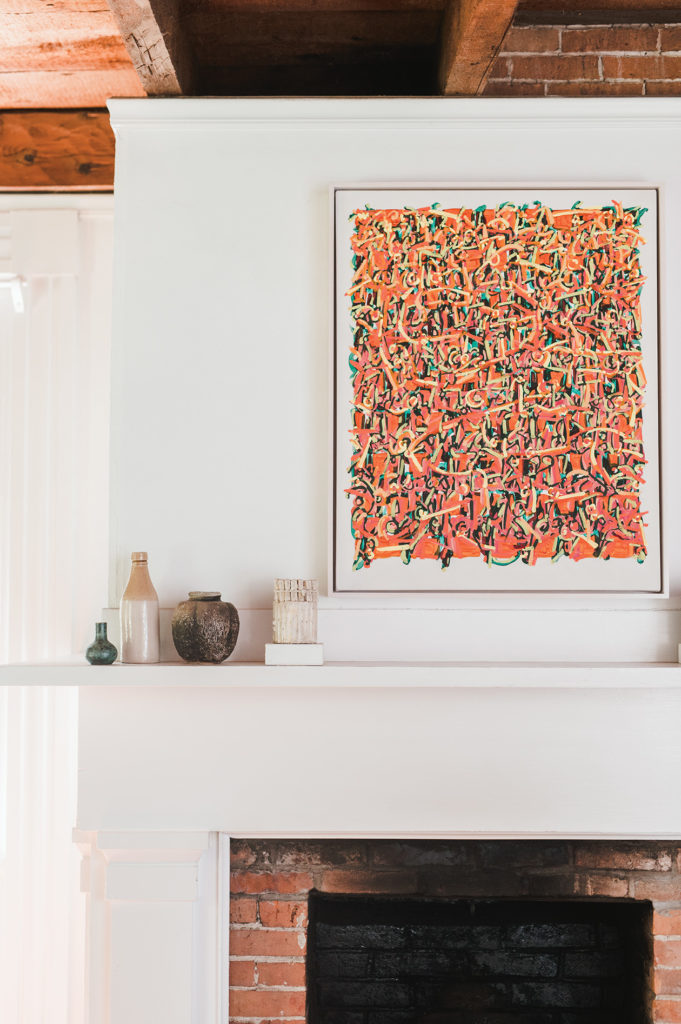Inside the Eighteenth-Century Home of Two Belfast Artists
Daniel Anselmi and Marc Leavitt use their 1790 farmhouse as the backdrop for their artwork.

The mountain route from Rockland to Belfast, skirting inland through the flower-filled meadows around Lincolnville, is one of the prettiest in the midcoast. Near the end of this road, just outside of Belfast’s downtown, is a farmhouse with dark clapboards and vibrant, well-tended greenery on every side. Marc Leavitt and Daniel Anselmi, a couple who are both self-taught abstract painters, call this 1790 farmhouse home, and the house itself has become a creative member of their family.
“We wanted to change our life,” says Leavitt. The couple, who met at Boston’s now-closed Waterstones Booksellers in the mid-1990s, bought the house in 2001 to escape from the city’s demands. Leavitt had created an innovative business as a resume writer, which, in the era leading up to the ubiquity of personal computers, was wildly successful but psychically draining. A more open, creative sensibility was possible in the Belfast house, which embodied an expectant emptiness, having been stripped bare by the previous owner. To Leavitt and Anselmi, that emptiness gestured toward the purity of a blank canvas. The couple first filled the house with beautiful antiques and rich, dark period colors. Today, this darkness has given way to light, bright, open spaces: the walls are painted white, and the rooms are spare and filled with carefully curated examples of the couple’s artwork, paired with a few elegant antique objects. The refreshing blankness of their studios in downtown Belfast inspired their clarity on their home’s new look. “At some point, we just wanted it all to be white and open,” Leavitt says.

The house has become a kind of studio of its own, as well as an art project. While Anselmi, an abstract painter known for his spare and melodic collage work, maintains a studio in downtown Belfast, Leavitt, whose artwork is an ongoing series of interconnected paintings, has relocated his work-space to the house. Meanwhile, the house’s renovation, which started in earnest in 2019, has allowed their mutual creative space to unfold. An attic has become a pristine storage area, with work stacked neatly under a pitched ceiling. A bright white sitting room has been reconstructed to look out over the back garden, where semi-tame chipmunks dart in and out of flowering verbena and daylilies. On the walls, Leavitt’s work faces Anselmi’s, demonstrating a contrasting sensibility that is at once divergent and deeply harmonious.

The library provides a treasure trove of historical art texts. 
In the sitting room, artwork from Leavitt (on the left wall) and Anselmi (on the back wall) welcomes visitors.
Characterized by an analytical approach to information and form, Leavitt’s painting practice stems from a challenge he set for himself years ago, to make a series of variations on the main formal themes of Jasper Johns’s 1957 masterpiece Flag on Orange Field. Over the course of many sets of iterations, Leavitt has carved out a unique method of working based on following sets of rules prescribed by his process. Like Sol LeWitt’s drawings from instructions, a keystone of conceptual art since the 1960s, Leavitt’s work allows the analytical to become playful and mysterious. Anselmi’s work, which is also nonobjective, comes from an opposing impulse. Instead of being rooted in systematic analysis, Anselmi’s practice comes from an intuitive, almost visionary approach. His collaged works, which are nearly monochromatic with bright additions of warm color, are lyrical and organic. Both artists, as different as their processes are, share a deep respect for intellectual curiosity, visual thinking, the structure of the grid, and the value of a good studio visit.

Self-taught as artists, Leavitt and Anselmi also have different wellsprings of learning. Leavitt, devoted to the history of art—Modernism in particular—has a library of orderly and pristine monographs and art history books, which cover a wide variety of artists from throughout history and across cultures. His work revels in quotations and references, adding depth and art-historical narrative to his projects. Anselmi, who worked as a window-dresser in department stores and shops before and after the couple’s move to Maine, has been creating fine art since 2007. After working on the visual design of a Belfast frame shop, his unique, astute artistic sensibility caught the attention of the shop’s owner. She offered him a solo show, if he would agree to make the work for it. He accepted the challenge and created his first-ever body of artwork for the occasion. Anselmi has found a wide audience for his work across the country ever since. Regular studio visits with each other are treated almost formally by the couple, who never impose on each other’s process, and always speak thoughtfully and with precision about one another’s work. They are mutually supportive, allowing ideas to resonate in regular, focused conversations about their projects. The same careful approach to creativity is seen in their relationship to their home.

With work by Anselmi on view across the space, the farmhouse becomes a dynamic two-person exhibition of contemporary painting.
The house itself is like a painting turned inside-out. The art book library, with a lovely portrait bust nestled between shelves of books—alphabetically arranged from Carla Accardi to Andy Warhol—is situated off a hallway that contains several of Leavitt’s text-based palimpsest abstractions. The kitchen, with a window that radiates the green-tinted light of the trees outside, contains a set of the couple’s works. A living room on the other side of the hall, beneath exposed hand-hewn beams, provides a setting for midcentury modern furniture and Anselmi’s sculptural experiments. These pieces recall the physicality of Nouveau Réalisme, a 1960s French art movement that valued the transfiguration of everyday objects. Leavitt’s workspace is in the middle of the house, with a long table covered by neat stacks of papers, art materials, and many notebooks. The atmosphere inside Leavitt and Anselmi’s home is nurturing yet energized, the site of rich, inquisitive conversation and a life built on the creative counterpoint of their relationship. Like a creative partner or a living artwork, the eighteenth-century farmhouse has the quality of a good listener who isn’t afraid to transform and grow. As Leavitt and Anselmi’s art-making practices bloom, their home forms the evidence of the breadth and generosity of their creative spirits.

Leavitt’s work is the second half of the two-person exhibition on view across the space. 
Eighteenth-century rafters and pristine modernism harmonize throughout Leavitt and Anselmi’s home.
Read more arts stories:
- The Immortal Life of Holly Meade

- “Beyond the Brick” Brings Maine-Made Art and Music to Life

- Watercolor Painter Abe Goodale Traces His Roots on 700 Acre Island

- Shifting Dynamics Through the Power of Theater


